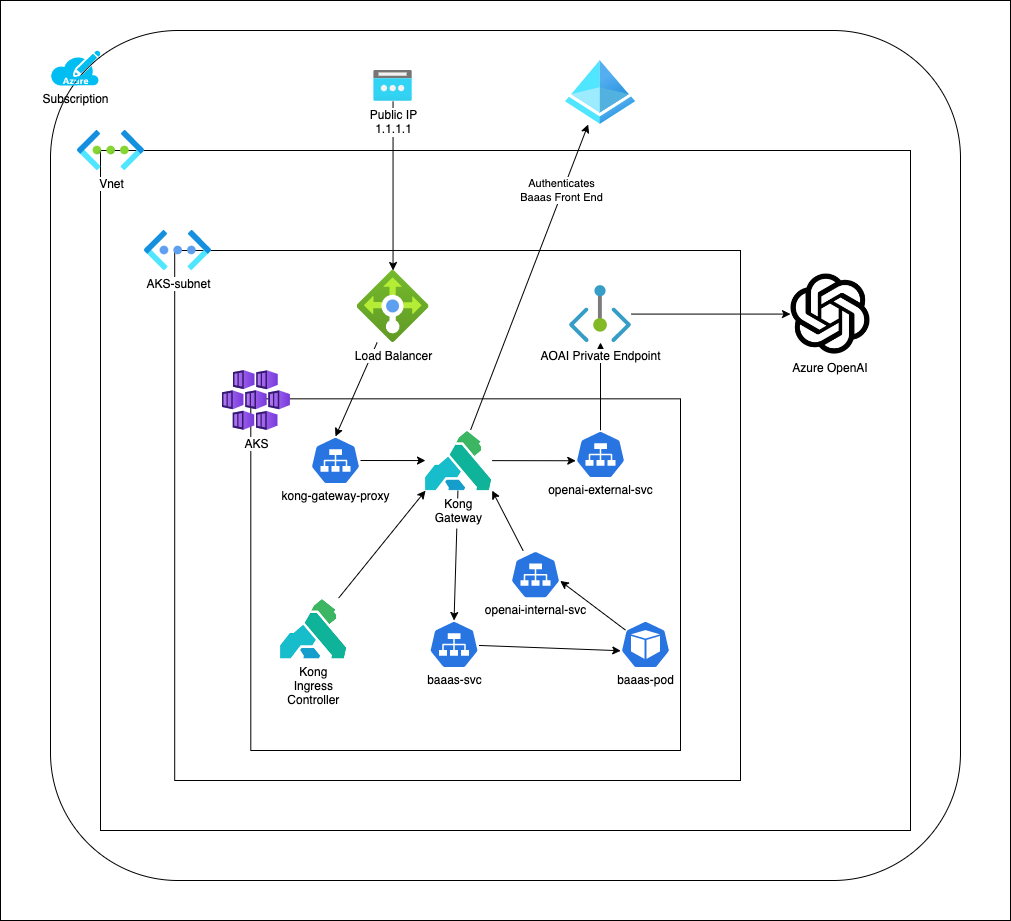This repo is designed to walk through the Azure OpenAI demo at Kong's API Summit.
This deployment uses the "Bad Advice As a Service" repo docker image as an "uninteresting" webapp which provides a simple UI interface for Azure OpenAI. Both the webapp and Azure OpenAI are fronted by Kong Ingress Controller.
This meets the following requirements for this demo:
- Deploy a simple webapp which uses OpenAI in Azure Kubernetes Service
- Demonstrate using Kong to secure both the webapp and OpenAI
- Prevent Azure OpenAI from being available from the public internet (use Private Endpoints)
Security Goals:
- Protect webapp with OIDC
- Rate-limit OpenAI requests
- Restrict OpenAI endpoint to only internal subnet
For simplicity sake, there are additional best practices which this repo does not follow, but are recommended:
- Azure Subscription
- Azure CLI
BAAAS_IMAGE=docker.io/lastcoolnameleft/bad-advice-generator
RG=api-summit
LOCATION=eastus
AKS_NAME=api-summit-aks
AOAI_NAME=api-summit-aoai
az group create -n $RG -l $LOCATION
az aks create -g $RG -n $AKS_NAME --enable-oidc-issuer
az aks get-credentials -g $RG -n $AKS_NAME
az cognitiveservices account create \
--name $AOAI_NAME \
--resource-group $RG \
--location $LOCATION \
--kind OpenAI \
--sku s0
az cognitiveservices account deployment create \
--name $AOAI_NAME \
--resource-group $RG \
--deployment-name text-davinci-003 \
--model-name text-davinci-003 \
--model-version "1" \
--model-format OpenAI \
--sku-capacity "1" \
--sku-name "Standard"
- Go into portal and enable custom domain
az cognitiveservices account show \
--resource-group $RG --name $AOAI_NAME \
--query properties.networkAcls.defaultAction
AOAI_RESOURCE_ID=$(az cognitiveservices account show --resource-group $RG --name $AOAI_NAME --query id --output tsv)
echo $AOAI_RESOURCE_ID
az resource update \
--ids $AOAI_RESOURCE_ID \
--set properties.networkAcls="{'defaultAction':'Deny'}"
AKS_NODE_RG=$(az aks show -g $RG -n $AKS_NAME --query nodeResourceGroup -o tsv)
# Assuming the first vnet in the AKS_NODE_RG is the one we want
AKS_VNET_NAME=$(az network vnet list -g $AKS_NODE_RG --query '[0].name' -o tsv)
AKS_SUBNET_NAME=$(az network vnet subnet list -g $AKS_NODE_RG --vnet-name $AKS_VNET_NAME --query '[0].name' -o tsv)
AKS_SUBNET_ID=$(az network vnet subnet list -g $AKS_NODE_RG --vnet-name $AKS_VNET_NAME --query '[0].id' -o tsv)
echo $AKS_NODE_RG
echo $AKS_VNET_NAME
echo $AKS_SUBNET_NAME
echo $AKS_SUBNET_ID
# Should return an empty list because we haven't added anything yet
az cognitiveservices account network-rule list \
--resource-group $RG --name $AOAI_NAME \
--query virtualNetworkRules
az network vnet subnet update -g $AKS_NODE_RG --name $AKS_SUBNET_NAME \
--vnet-name $AKS_VNET_NAME --service-endpoints "Microsoft.CognitiveServices"
# Use the captured subnet identifier as an argument to the network rule addition
az cognitiveservices account network-rule add \
--resource-group $RG --name $AOAI_NAME \
--subnet $AKS_SUBNET_ID
# Should now return a single row
az cognitiveservices account network-rule list \
--resource-group $RG --name $AOAI_NAME \
--query virtualNetworkRules
AOAI_ENDPOINT=$(az cognitiveservices account show -n $AOAI_NAME -g $RG --query 'properties.endpoint' -o tsv)
AOAI_KEY=$(az cognitiveservices account keys list -n $AOAI_NAME -g $RG --query 'key1' -o tsv)
echo $AOAI_ENDPOINT
echo $AOAI_KEY
kubectl create secret generic aoai --from-literal=OPENAI_API_KEY=$AOAI_KEY --from-literal=OPENAI_ENDPOINT=https://openai-internal-service
kubectl apply -f k8s/deployment.yaml
https://docs.konghq.com/kubernetes-ingress-controller/latest/
kubectl create namespace kong
helm repo add kong https://charts.konghq.com
helm repo update
# From the Kong Portal, download the certificate and key
kubectl create secret tls konnect-client-tls -n kong --cert=./tls.crt --key=./tls.key
# From the Kong Portal, download the values.yaml file
helm install kong kong/ingress -n kong --values ./values.yaml
# https://docs.konghq.com/kubernetes-ingress-controller/latest/guides/cert-manager/
# https://cert-manager.io/docs/installation/
kubectl apply -f https://github.com/cert-manager/cert-manager/releases/download/v1.12.4/cert-manager.yaml
Inspired by Kong's OIDC documentation and Kong's OIDC AAD documentation
Register an App in Azure Active Directory
Notable values to copy from App Registration into k8s definitions
- Issuer: e.g. https://login.microsoftonline.com/16b3c013-d300-468d-ac64-7eda0820b6d3
- Application (Client) ID: e.g. 1efaa100-501f-4055-a6a7-490b40b832df
- Redirect URL: e.g. https://20.127.181.57.nip.io/
- Client Secret: e.g. XXXXX~YYYY_ZZZZ0000
# update k8s/kong-plugin-oidc.yaml with the specific OIDC values
kubectl apply -f k8s/kong-plugin-oidc.yaml
# update k8s/ingress-web.yaml with your public IP and email address (it will fail with example.com email)
kubectl apply -f k8s/ingress-web.yaml
Inspired by Kong's rate limiting documentation and examples
# update k8s/ingress-openai.yaml with Azure OpenAI endpoint
kubectl apply -f k8s/kong-plugin-rate-limit.yaml
kubectl apply -f k8s/ingress-openai.yaml
